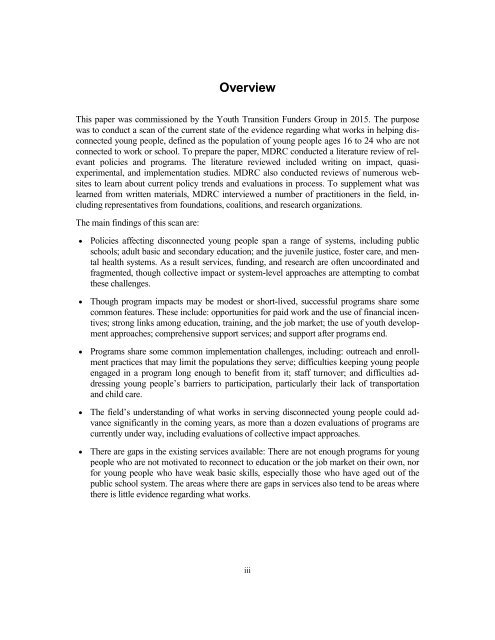Opportunity Youth: Disenfranchised Young People
Opportunity Youth: Disenfranchised Young People
Opportunity Youth: Disenfranchised Young People
You also want an ePaper? Increase the reach of your titles
YUMPU automatically turns print PDFs into web optimized ePapers that Google loves.
Overview<br />
This paper was commissioned by the <strong>Youth</strong> Transition Funders Group in 2015. The purpose<br />
was to conduct a scan of the current state of the evidence regarding what works in helping disconnected<br />
young people, defined as the population of young people ages 16 to 24 who are not<br />
connected to work or school. To prepare the paper, MDRC conducted a literature review of relevant<br />
policies and programs. The literature reviewed included writing on impact, quasiexperimental,<br />
and implementation studies. MDRC also conducted reviews of numerous websites<br />
to learn about current policy trends and evaluations in process. To supplement what was<br />
learned from written materials, MDRC interviewed a number of practitioners in the field, including<br />
representatives from foundations, coalitions, and research organizations.<br />
The main findings of this scan are:<br />
• Policies affecting disconnected young people span a range of systems, including public<br />
schools; adult basic and secondary education; and the juvenile justice, foster care, and mental<br />
health systems. As a result services, funding, and research are often uncoordinated and<br />
fragmented, though collective impact or system-level approaches are attempting to combat<br />
these challenges.<br />
• Though program impacts may be modest or short-lived, successful programs share some<br />
common features. These include: opportunities for paid work and the use of financial incentives;<br />
strong links among education, training, and the job market; the use of youth development<br />
approaches; comprehensive support services; and support after programs end.<br />
• Programs share some common implementation challenges, including: outreach and enrollment<br />
practices that may limit the populations they serve; difficulties keeping young people<br />
engaged in a program long enough to benefit from it; staff turnover; and difficulties addressing<br />
young people’s barriers to participation, particularly their lack of transportation<br />
and child care.<br />
• The field’s understanding of what works in serving disconnected young people could advance<br />
significantly in the coming years, as more than a dozen evaluations of programs are<br />
currently under way, including evaluations of collective impact approaches.<br />
• There are gaps in the existing services available: There are not enough programs for young<br />
people who are not motivated to reconnect to education or the job market on their own, nor<br />
for young people who have weak basic skills, especially those who have aged out of the<br />
public school system. The areas where there are gaps in services also tend to be areas where<br />
there is little evidence regarding what works.<br />
iii

















